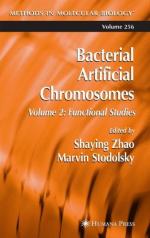|
This section contains 554 words (approx. 2 pages at 300 words per page) |

|
Bacterial artificial chromosomes (BACs) involve a cloning system that is derived from a particular plasmid found in the bacterium Escherichia coli. The use of the BAC allows large pieces of deoxyribonucleic acid (DNA) from bacterial or nonbacterial sources to be expressed in Escherichia coli. Repeated expression of the foreign DNA produces many copies in the bacterial cells, providing enough material for analysis of the sequence of the DNA. BACs proved useful in the sequencing of the human genome.
The BAC is based on a plasmid in Escherichia coli that is termed the F (for fertility) plasmid. The F plasmid (or F factor) contains information that makes possible the process called conjugation. In conjugation, two Escherichia coli bacteria can physically connect and an exchange of DNA can occur.
A BAC contains the conjugation promoting genetic information as well as stretch of DNA that...
|
This section contains 554 words (approx. 2 pages at 300 words per page) |

|


